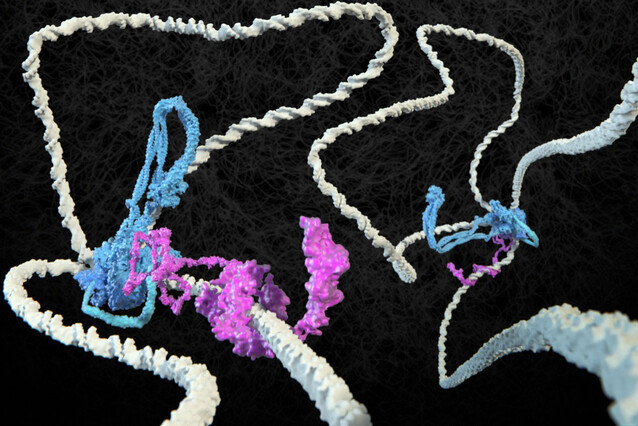Architects of the genome

Fitting two metres of DNA into a microscopic cell nucleus: that is the challenge that cohesin takes on, folding long chromosomes into many loops. CTCF, a nuclear protein, binds to DNA and acts as a barrier to cohesin, regulating its activity and restraining loop formation to specific areas of the genome. In a study published in Nature, IMP scientists and collaborators visualise CTCF in real time, showing that its role as a regulator of genome architecture is much more fine-tuned than expected.
In fungi, plants, and animals, chromosomes are neatly packaged and stored in the cell nucleus. The protein complex cohesin is a major actor in this process, as it folds DNA into numerous loops.
Loops form within given areas of the genome: topologically associated domains, or TADs. The protein CTCF, which binds to specific sequences of DNA, demarcates TADs and acts as a barrier on cohesin’s path. Together, cohesin and CTCF contribute to shaping the architecture of our genome. DNA loops are implicated in crucial cellular processes: the assembly of chromosomes, gene regulation, and recombination.
For the past few years, scientists have hypothesised that CTCF forms a strict boundary, always denying cohesin passage if they come in contact. However, there had been few studies to pinpoint how CTCF performs this function, and whether it is as inflexible as predicted.
The lab of Jan-Michael Peters at the IMP and Roman Barth in Cees Dekker’s lab at Delft University of Technology have developed an assay to visualise single cohesin molecules and their interaction with CTCF in real time. In their study in the journal Nature, they show that CTCF is an active, flexible regulator of DNA loop extrusion, and a crucial genome organiser.
A flexible barrier
The scientists found that the orientation of CTCF when it binds DNA determines whether cohesin will be blocked or not. This is the first direct line of evidence that CTCF is a directional barrier to cohesin. The story continues with unexpected findings on the mechanisms that link these two molecules.
“We observed cohesin encountering CTCF on one side of the loop and staying bound to it while continuing to pull DNA from the other side of the loop. This suggests that CTCF acts as an anchor, holding cohesin and preventing it from pulling DNA on one side,” explains Iain Davidson, co-first author of the study.
In some cases, CTCF brings cohesin to a complete halt, to the point where hard-won loops shrink back to smaller sizes. How the role of CTCF is modulated was the next question to address, and the researchers made a surprising discovery: DNA tension is the key.
DNA tension sets the tone
In order to visualise the process, the team tethered single molecules of DNA to a glass surface: some were stretched, while others were loose. In situations where the DNA molecules were looser, CTCF was a more permeable barrier than when DNA was stretched at a high tension.
The underlying mechanism is yet to be described: it could be that since cohesin cannot loop DNA as efficiently when it is stretched, this might allow CTCF to form more stable interactions with cohesin. The authors speculate that the local tension within chromosomes could affect the efficiency of CTCF as a brake to loop formation. Basic cellular processes such as gene transcription and DNA replication during the cell cycle affect DNA tension at a local scale and may modulate CTCF’s role in organising our genome.
“Our work tackles a key question at the heart of chromosome biology. It shows that CTCF sites are important and multi-functional regulators of DNA looping,” says IMP Scientific Director Jan-Michael Peters. “Our next step is to use biophysical approaches to understand how CTCF’s barrier activity is so tightly regulated by DNA tension.”
Original publication
Iain F. Davidson*, Roman Barth*, Maciej Zaczek*, Jaco van der Torre, Wen Tang, Kota Nagasaka, Richard Janissen, Jacob Kerssemakers, Gordana Wutz, Cees Dekker# and Jan-Michael Peters#: “CTCF is a DNA-tension-dependent barrier to cohesin-mediated DNA loop extrusion”. Nature (2023), DOI: 10.1038/s41586-023-05961-5.
*co-first authors
#co-corresponding authors
Further reading
Research with Jan-Michael Peters
Gene transcription hampers cohesin’s travel along chromosomes